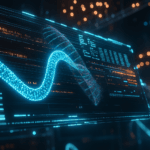A new era of computing possibilities has emerged in recent years as a result of the quick development of artificial intelligence and its numerous uses. Neural networks, the foundation of contemporary AI, have proven to be incredibly powerful in a variety of fields, from image recognition and natural language processing to autonomous systems and robotics.
On traditional processors, real-time execution and scalability are hampered by the computational complexity of neural network inference, which has grown to be a considerable bottleneck.
To improve the performance of neural network inference and address these issues, researchers and engineers have resorted to hardware acceleration. Field-Programmable Gate Arrays (FPGAs) are one of the new hardware technologies that have drawn a lot of interest.
Custom neural network accelerators can be implemented using FPGAs because of their special combination of reconfigurability, parallelism, and energy efficiency.
The ability to obtain significant speedups and energy savings by adjusting FPGA architectures to neural network computational patterns enables AI applications to succeed in resource-constrained environments and edge computing scenarios.
The implementation of neural network accelerators on FPGAs is the subject of this article, which also examines its theoretical underpinnings and advantages.
We will examine the foundations of neural networks and how they make inferences in order to obtain insight into the difficulties that traditional processors encounter when dealing with deep learning models.
Basics of Neural Networks and Inference
The neural architecture of the human brain served as the inspiration for neural network computational models. They are made up of interconnected layers of synthetic neurons, each with parameters that can be learned, like weights and biases. Neural networks are created to process and learn from data, allowing them to identify patterns, forecast outcomes, and complete challenging tasks.
A. Overview of Neural Network Architectures
- Feedforward Neural Networks: Feedforward neural networks, sometimes referred to as multi-layer perceptrons (MLPs), have an input layer, one or more hidden layers, and an output layer. From the input layer via the hidden layers to the output layer, data moves in a single direction. Weighted connections link every neuron in a layer to every neuron in the layer’s neighboring layers.
- Convolutional Neural Networks (CNNs): CNNs are generally employed for jobs involving image and video analysis. To automatically find patterns and characteristics in the input data, they use convolutional layers. CNNs are effective for processing huge images since they have fewer parameters thanks to the usage of shared weights and pooling layers.
- Recurrent Neural Networks (RNNs): Sequential data, like time series or natural language, is what RNNs are made to handle. They make use of feedback loops, which let data survive and have an impact on predictions in the future. Popular RNN variations that address the vanishing gradient issue include Long Short-Term Memory (LSTM) and Gated Recurrent Unit (GRU).
B. Feedforward and Backpropagation Processes
The fundamental operations in a neural network are forward propagation (inference) and backpropagation (training).
- Forward Propagation: Forward propagation involves feeding data into the input layer, which then performs calculations layer by layer until the output layer generates the final forecast. An activation function, such as the ReLU (Rectified Linear Unit) or sigmoid, is used to determine each neuron’s level of activation. The output’s accuracy and loss are calculated by contrasting it with the actual data.
- Backpropagation: Backpropagation is the process of altering the weights and biases of the neural network depending on the calculated loss experienced during forward propagation. It entails employing optimization techniques like stochastic gradient descent (SGD) or its variants to alter the parameters by computing the gradient of the loss with respect to each parameter.
C. Inference Process in Neural Networks
Applying a trained neural network to new, unexplored data to produce predictions is the process of inference. The neural network becomes a function that maps input data to output predictions once it has been trained using backpropagation.
- Data Preprocessing: In order to ensure that the input data meets the neural network’s input criteria, input data frequently needs to be preprocessed before predictions can be made, for as by normalizing or resizing.
- Forward Pass: The forward pass, which is carried out during inference, involves feeding input data through the layers of the neural network and computing activations up until the output is produced.
- Output Interpretation: Based on the particular job, the neural network’s output can be understood. For instance, the result in image classification could show the class probabilities, whereas the output in regression might be a continuous value.
Overview of FPGA Technology
Field-programmable gate arrays are semiconductors that can be designed and programmed after they have been manufactured. FPGAs can be configured to the precise needs of the neural network model being implemented, in contrast to Application-Specific Integrated Circuits (ASICs), which have fixed functionality. since their versatility, FPGAs are a desirable option for neural network acceleration since they can be adjusted for both performance and power consumption.
Benefits of Implementing Neural Network Accelerators on FPGAs
- Speed: Due to their capacity for parallel computation and ability to take advantage of neural networks’ intrinsic parallelism, FPGAs are capable of achieving astounding processing speeds. Faster inference times and lower latency are the end results, which are essential for real-time applications.
- Energy Efficiency: FPGAs are known for their low power consumption compared to CPUs and GPUs. By efficiently utilizing hardware resources, neural network accelerators on FPGAs can achieve impressive performance-per-watt metrics, making them suitable for power-constrained environments.
- Customization: With FPGAs, designers have the freedom to create custom hardware architectures tailored to the specific neural network model, achieving higher efficiency compared to one-size-fits-all solutions.
- Reconfigurability: FPGAs can be reprogrammed and updated even after deployment, allowing for the incorporation of new neural network models or optimizations without hardware changes.
- Edge Computing: The compact size and low power consumption of FPGAs make them ideal for edge computing scenarios, where processing is performed locally on devices rather than in the cloud.
Popular FPGA-Based Neural Network Accelerators
The adoption of FPGA-based neural network accelerators has gained momentum due to their exceptional performance and flexibility. Several cutting-edge accelerators have emerged, each tailored to address specific neural network architectures and tasks. In this section, we explore some of the popular FPGA-based neural network accelerators that have made significant contributions to the field of AI hardware acceleration.
1. Binarized Neural Networks (BNNs) on FPGAs:
Binarized Neural Networks are a particular kind of neural network that uses binary numbers (-1 or +1) to represent weights and activations rather than the more common floating-point or fixed-point representations. This enables extremely small memory footprints and more straightforward computations. Due to their capacity for effective parallel execution of binary operations, FPGAs are particularly well suited for implementing BNNs. For edge devices with limited resources, BNNs on FPGAs have demonstrated excellent speed and power efficiency.
2. FPGA-Based Deep Learning Processing Units (DPUs):
Deep Learning Processing Units built on FPGA are flexible accelerators intended to serve a range of neural network activities and topologies. Hardware optimizations for basic operations like matrix multiplications and convolutions are frequently incorporated into DPUs, allowing for faster and more effective inference. These DPUs are suitable for a variety of AI applications since they can be reprogrammed to conform to various neural network models.
3. Winograd-Optimized Convolutional Neural Networks (WINO-CONV) Accelerators:
Convolutions are the most computationally costly processes in convolutional neural networks (CNNs), which are frequently employed in image and video processing applications. Accelerators that have been Winograd-optimized use the Winograd minimal filtering algorithm to minimize the number of multiplications needed for convolutions, which speeds up inference. With their capacity for parallel processing, FPGAs may effectively execute the Winograd method, leading to appreciable speedups.
4. Quantized Neural Network (QNN) Accelerators:
Reduced precision in neural network weights and activations is achieved by a technique called quantization, which may result in more effective hardware implementations. The execution of quantized neural networks is optimized by FPGA-based QNN accelerators, offering a fair balance between accuracy and computing speed. For the deployment of neural network models on edge devices with constrained resources, these accelerators are extremely useful.
5. FPGA-based Recurrent Neural Network (RNN) Accelerators:
For sequential data processing applications like time series analysis and natural language processing, recurrent neural networks are frequently used. Specialized designs that can effectively manage sequential data and recurrent connections are needed to implement RNNs on FPGAs. These issues are addressed by FPGA-based RNN accelerators, which provide high-performance and energy-efficient solutions for sequential processing jobs.
Future Trends in FPGA-Based Neural Network Acceleration
As technology continues to evolve, FPGA-based neural network acceleration is poised to play a crucial role in shaping the future of artificial intelligence and machine learning applications. Several exciting trends are emerging in this field, each promising to further enhance the efficiency, performance, and versatility of FPGA-based accelerators.
1. Emerging FPGA Technologies and Architectures:
In order to provide greater capacities, faster processing speeds, and reduced power consumption, FPGA makers are continually releasing new and enhanced technology. Advanced FPGA architectures with functions like dedicated multiply-accumulate (MAC) units, decreased precision arithmetic support, and efficient memory hierarchies are being developed expressly for deep learning applications. These developments make it possible to deploy more sophisticated neural network models on FPGAs with even greater performance.
2. Hardware-Software Co-design for Neural Network Accelerators:
Future developments in FPGA-based neural network acceleration will emphasize more hardware-software convergence. By using co-design approaches, programmers will be able to simultaneously optimize the hardware architecture and the neural network model, making the most of the FPGA platform’s capabilities. This method can provide extremely effective, specially designed-accelerators that significantly improve performance.
3. Integration with Edge Devices and IoT Applications:
The demand for on-device AI processing is being driven by the growth of edge computing and Internet of Things (IoT) devices. FPGAs are the best choice for deployment in resource-constrained edge devices because of their low power consumption and adaptable architecture. FPGA-based neural network accelerators will find more widespread uses in industries like smart cameras, autonomous vehicles, and wearable technology as the demand for intelligent edge devices rises.
4. Enhanced Support for Large-Scale Neural Network Models:
FPGA-based accelerators will need to change to support these more complicated, larger neural network models as they continue to expand in size. The deployment of large neural network designs while preserving low latency and high throughput is made possible through research on distributed computing techniques that span numerous FPGAs.
5. Compiler and Toolchain Advancements:
For FPGA-based neural network accelerators to be widely adopted, the design process must be made simpler. The development of accelerators will be facilitated by improvements in High-Level Synthesis (HLS) tools and deep learning frameworks that seamlessly interact with FPGA design, lowering development time and expertise requirements.
6. Accelerator-as-a-Service (AaaS):
Accelerators for neural networks built on FPGA are now being made available by cloud service providers. Due to this trend, customers can benefit from FPGA acceleration without needing to have a deep understanding of FPGA deployment and design. A wider range of developers will be able to take advantage of these potent accelerators as a result of the availability of AaaS platforms, which will democratize access to FPGA acceleration.
Conclusion
The use of neural network accelerators on FPGAs provides a potent solution to the rising processing needs of AI applications. FPGAs are perfect for designing custom accelerators due to their reconfigurability, parallelism, and energy efficiency, which results in significant performance increases.
Future developments include sophisticated FPGA topologies, hardware-software co-design, and interaction with edge devices promise to further improve FPGA-based neural network acceleration as technology develops. AI computing will be transformed by this innovative strategy, making it more usable, effective, and adaptable across a range of sectors and applications. Future neural network acceleration with FPGAs has a huge potential to lead to ground-breaking developments in artificial intelligence.


![What is FPGA Introduction to FPGA Basics [2023] computer-chip-dark-background-with-word-intel-it](https://fpgainsights.com/wp-content/uploads/2023/06/computer-chip-dark-background-with-word-intel-it-300x171.jpg)









